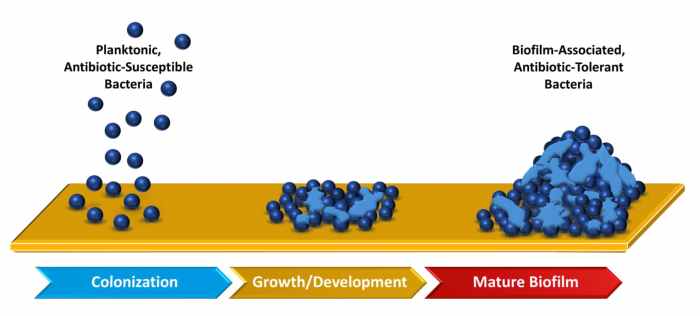Biofilms typically do not develop on healthy tissue – Biofilms, complex communities of microorganisms, typically do not develop on healthy tissue, providing a fascinating insight into the intricate mechanisms that protect our bodies. This article delves into the reasons behind this phenomenon, exploring the factors that contribute to biofilm resistance on healthy tissue and the implications for medical treatment.
Healthy tissue possesses inherent defense mechanisms that effectively prevent biofilm colonization. These mechanisms include the constant shedding of surface cells, the production of antimicrobial peptides, and the presence of immune cells that actively combat invading microorganisms. As a result, biofilms are rarely able to establish a foothold on healthy tissue, ensuring its integrity and proper functioning.
Biofilm Formation and Development

Biofilms are complex communities of microorganisms that adhere to surfaces and are encased in a self-produced extracellular matrix. Biofilm formation is a multi-step process involving the initial attachment of bacteria to a surface, followed by the formation of microcolonies and the production of the extracellular matrix.
Various factors contribute to biofilm development, including the availability of nutrients, the surface properties, and the presence of antimicrobial agents.
Factors Contributing to Biofilm Development, Biofilms typically do not develop on healthy tissue
- Nutrient availability: Biofilms typically form in nutrient-rich environments, as the availability of nutrients supports the growth and proliferation of microorganisms.
- Surface properties: The surface properties of the material can influence biofilm formation. Rough and porous surfaces provide more attachment sites for bacteria, facilitating the initial colonization.
- Antimicrobial agents: The presence of antimicrobial agents can select for biofilm-forming bacteria. Biofilms provide a protective environment for microorganisms, shielding them from the effects of antimicrobial agents.
Healthy Tissue and Biofilm Resistance

Biofilms typically do not develop on healthy tissue due to the presence of host defense mechanisms that protect against microbial colonization. These mechanisms include:
Mechanisms Protecting Healthy Tissue from Biofilm Colonization
- Intact epithelial barriers: The intact epithelial layer acts as a physical barrier, preventing microorganisms from adhering to the underlying tissue.
- Immune surveillance: The immune system constantly monitors for the presence of foreign microorganisms and responds by eliminating them through phagocytosis and antibody production.
- Antimicrobial peptides: Healthy tissue produces antimicrobial peptides that can directly kill or inhibit the growth of microorganisms.
Exceptions and Conditions

While biofilms typically do not form on healthy tissue, there are exceptions to this rule. Certain conditions or circumstances can lead to biofilm formation on healthy tissue, including:
Conditions Leading to Biofilm Formation on Healthy Tissue
- Immunosuppression: Individuals with weakened immune systems are more susceptible to biofilm infections, as their immune defenses are compromised.
- Medical devices: The presence of medical devices, such as catheters or implants, can provide a nidus for biofilm formation on healthy tissue.
- Chronic wounds: Chronic wounds create a nutrient-rich environment that can support biofilm formation.
Implications for Medical Treatment

The resistance of biofilms to antimicrobial agents and host defense mechanisms poses significant challenges for medical treatments. Biofilm infections are often difficult to treat and can lead to persistent infections and chronic conditions.
Strategies for Preventing and Treating Biofilm Infections in Healthy Tissue
- Prevention: Preventing biofilm formation on healthy tissue is crucial to reduce the risk of biofilm-related infections. This can involve maintaining intact epithelial barriers, strengthening immune responses, and reducing the use of antimicrobial agents.
- Treatment: Treating biofilm infections in healthy tissue requires a combination of approaches, including surgical debridement to remove the biofilm, antimicrobial therapy, and host-directed therapies to enhance the immune response.
Biofilm Management in Healthcare
Biofilm management in healthcare settings is essential to prevent and control biofilm-related infections. This involves:
Biofilm Management Strategies in Healthcare Settings
- Antimicrobial agents: Antimicrobial agents can be used to treat biofilm infections, although their efficacy can be limited due to the protective nature of the biofilm.
- Surface modifications: Modifying the surfaces of medical devices or implants can reduce biofilm formation by creating less favorable conditions for bacterial attachment.
- Other approaches: Other approaches to biofilm management include the use of antimicrobial peptides, bacteriophages, and quorum sensing inhibitors.
Future Research Directions: Biofilms Typically Do Not Develop On Healthy Tissue
Further research is needed to improve our understanding of biofilm formation and development on healthy tissue. This research should focus on:
Areas for Future Research on Biofilm Formation and Development on Healthy Tissue
- Investigating the mechanisms by which healthy tissue resists biofilm colonization.
- Identifying the factors that contribute to biofilm formation on healthy tissue in specific conditions or circumstances.
- Developing novel strategies to prevent and treat biofilm infections on healthy tissue.
FAQ Resource
Why do biofilms typically not develop on healthy tissue?
Healthy tissue possesses inherent defense mechanisms, such as constant cell shedding, antimicrobial peptides, and immune cells, that effectively prevent biofilm colonization.
Are there any exceptions to the rule that biofilms do not form on healthy tissue?
Yes, there are specific conditions or circumstances, such as compromised immune function or the presence of medical devices, that can lead to biofilm formation on healthy tissue.
What are the implications of biofilm resistance on healthy tissue for medical treatments?
Biofilm resistance on healthy tissue can complicate medical treatments, as biofilms can protect microorganisms from antimicrobial agents and hinder the effectiveness of surgical interventions.